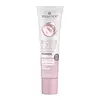What's inside
What's inside
 Key Ingredients
Key Ingredients

 Benefits
Benefits

 Concerns
Concerns

 Ingredients Side-by-side
Ingredients Side-by-side

Water
Skin ConditioningHordeum Vulgare Seed Flour
AbrasiveDiethylhexyl Carbonate
EmollientCoco-Caprylate
EmollientNiacinamide
SmoothingPolyglyceryl-4 Diisostearate/Polyhydroxystearate/Sebacate
EmulsifyingOryza Sativa Starch
AbsorbentHydrogenated Castor Oil
EmollientMagnesium Sulfate
Tocopherol
AntioxidantOctyldodecanol
EmollientDisteardimonium Hectorite
StabilisingPropylene Carbonate
SolventPhenoxyethanol
PreservativeBenzoic Acid
MaskingDehydroacetic Acid
PreservativeParfum
MaskingTetramethyl Acetyloctahydronaphthalenes
MaskingDimethyl Phenylethyl Carbinyl Acetate
PerfumingCI 77491
Cosmetic ColorantCI 77492
Cosmetic ColorantCI 77499
Cosmetic ColorantWater, Hordeum Vulgare Seed Flour, Diethylhexyl Carbonate, Coco-Caprylate, Niacinamide, Polyglyceryl-4 Diisostearate/Polyhydroxystearate/Sebacate, Oryza Sativa Starch, Hydrogenated Castor Oil, Magnesium Sulfate, Tocopherol, Octyldodecanol, Disteardimonium Hectorite, Propylene Carbonate, Phenoxyethanol, Benzoic Acid, Dehydroacetic Acid, Parfum, Tetramethyl Acetyloctahydronaphthalenes, Dimethyl Phenylethyl Carbinyl Acetate, CI 77491, CI 77492, CI 77499
Water
Skin ConditioningButylene Glycol
HumectantCellulose
AbsorbentNiacinamide
SmoothingPropanediol
SolventPentylene Glycol
Skin ConditioningSodium Polyacrylate Starch
AbsorbentPanthenol
Skin ConditioningEnantia Chlorantha Bark Extract
Skin ConditioningCaprylyl Glycol
EmollientAllantoin
Skin ConditioningBetaine
HumectantOleanolic Acid
Skin ConditioningLactic Acid
BufferingSodium Alum
AstringentCitric Acid
BufferingBenzyl Alcohol
PerfumingBenzoic Acid
MaskingParfum
MaskingCI 42090
Cosmetic ColorantCI 45410
Cosmetic ColorantAlternatives
Ingredients Explained
These ingredients are found in both products.
Ingredients higher up in an ingredient list are typically present in a larger amount.
Benzoic Acid is used to preserve and adjust the pH of products.
The antimicrobial property of Benzoic Acid helps elongate a product's shelf life. Its main role is to reduce fungi growth and is not found to be effective at fighting bacteria. Therefore Benzoic Acid is always added along with other preservatives.
In its pure form, Benzoic Acid looks like a white crystalline solid. It has slight solubility in water.
The name of Benzoic Acid comes from gum benzoin, which used to be the sole source of deriving this ingredient. Benzoic Acid is the most simple aromatic carboxylic acid.
Benzoic Acid is naturally occuring in strawberries, mustard, cinnamon, and cloves. It has a slight scent but is not considered to be a fragrance.
Learn more about Benzoic AcidNiacinamide is a multitasking form of vitamin B3 that strengthens the skin barrier, reduces pores and dark spots, regulates oil, and improves signs of aging.
And the best part? It's gentle and well-tolerated by most skin types, including sensitive and reactive skin.
You might have heard of "niacin flush", or the reddening of skin that causes itchiness. Niacinamide has not been found to cause this.
In very rare cases, some individuals may not be able to tolerate niacinamide at all or experience an allergic reaction to it.
If you are experiencing flaking, irritation, and dryness with this ingredient, be sure to double check all your products as this ingredient can be found in all categories of skincare.
When incorporating niacinamide into your routine, look out for concentration amounts. Typically, 5% niacinamide provides benefits such as fading dark spots. However, if you have sensitive skin, it is better to begin with a smaller concentration.
When you apply niacinamide to your skin, your body converts it into nicotinamide adenine dinucleotide (NAD). NAD is an essential coenzyme that is already found in your cells as "fuel" and powers countless biological processes.
In your skin, NAD helps repair cell damage, produce new healthy cells, support collagen production, strengthen the skin barrier, and fight environmental stressors (like UV and pollution).
Our natural NAD levels start to decline with age, leading to slower skin repair, visible aging, and a weaker skin barrier. By providing your skin niacinamide, you're recharging your skin's NAD levels. This leads to stronger, healthier, and younger looking skin.
Another name for vitamin B3 is nicotinamide. This vitamin is water-soluble and our bodies don't store it. We obtain Vitamin B3 from either food or skincare. Meat, fish, wheat, yeast, and leafy greens contain vitamin B3.
The type of niacinamide used in skincare is synthetically created.
Learn more about NiacinamideParfum is a catch-all term for an ingredient or more that is used to give a scent to products.
Also called "fragrance", this ingredient can be a blend of hundreds of chemicals or plant oils. This means every product with "fragrance" or "parfum" in the ingredients list is a different mixture.
For instance, Habanolide is a proprietary trade name for a specific aroma chemical. When used as a fragrance ingredient in cosmetics, most aroma chemicals fall under the broad labeling category of “FRAGRANCE” or “PARFUM” according to EU and US regulations.
The term 'parfum' or 'fragrance' is not regulated in many countries. In many cases, it is up to the brand to define this term.
For instance, many brands choose to label themselves as "fragrance-free" because they are not using synthetic fragrances. However, their products may still contain ingredients such as essential oils that are considered a fragrance by INCI standards.
One example is Calendula flower extract. Calendula is an essential oil that still imparts a scent or 'fragrance'.
Depending on the blend, the ingredients in the mixture can cause allergies and sensitivities on the skin. Some ingredients that are known EU allergens include linalool and citronellol.
Parfum can also be used to mask or cover an unpleasant scent.
The bottom line is: not all fragrances/parfum/ingredients are created equally. If you are worried about fragrances, we recommend taking a closer look at an ingredient. And of course, we always recommend speaking with a professional.
Learn more about ParfumWater. It's the most common cosmetic ingredient of all. You'll usually see it at the top of ingredient lists, meaning that it makes up the largest part of the product.
So why is it so popular? Water most often acts as a solvent - this means that it helps dissolve other ingredients into the formulation.
You'll also recognize water as that liquid we all need to stay alive. If you see this, drink a glass of water. Stay hydrated!
Learn more about Water